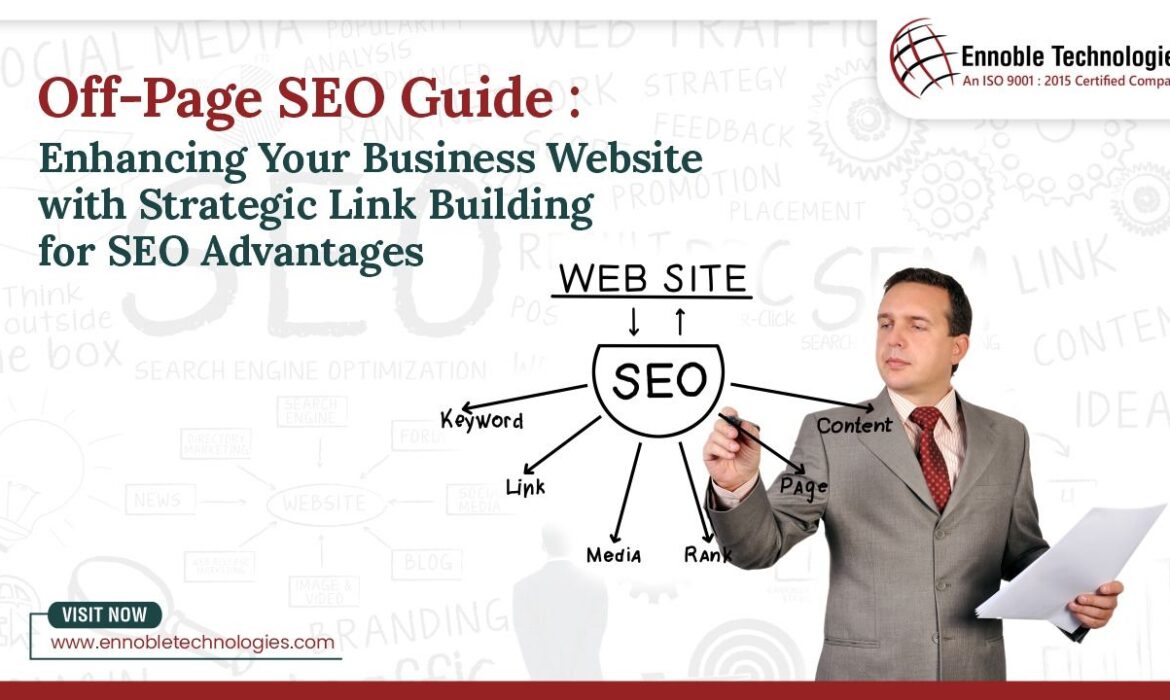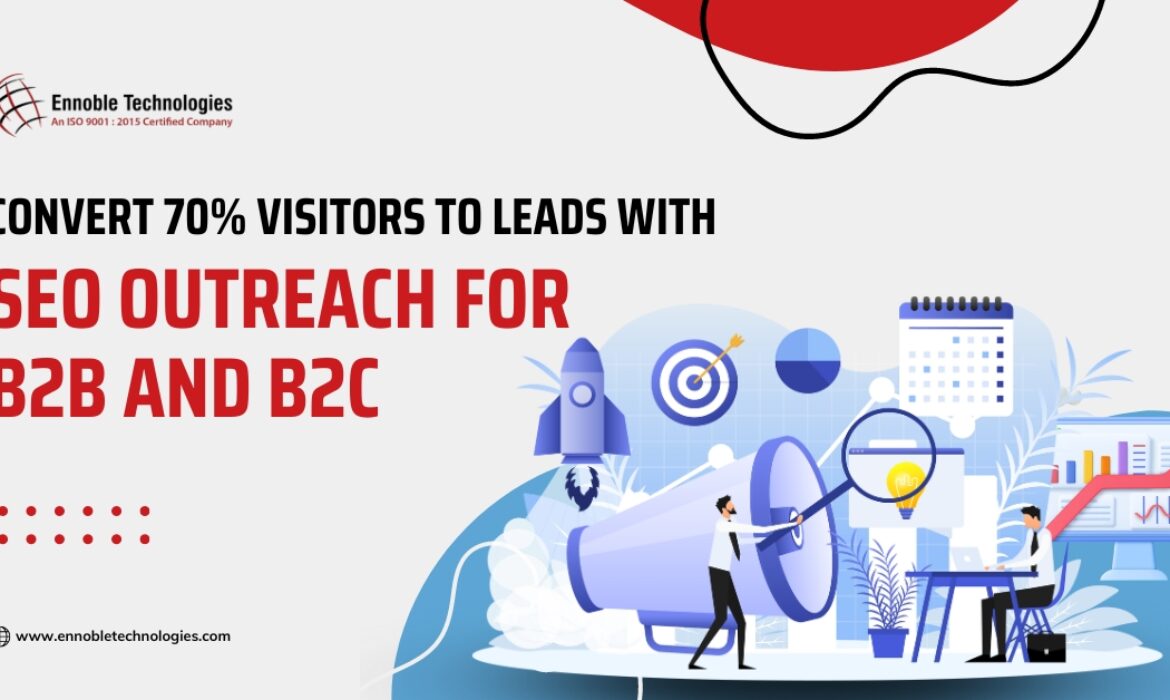Off-Page SEO Guide: Enhancing Your Business Website with Strategic Link Building for SEO Advantages
Introduction
In the world of digital marketing, Off-Page SEO plays a critical role in enhancing the visibility and ranking of websites on search engine results pages (SERPs). It focuses on optimizing factors outside the website itself, such as link building and online reputation management. Let’s delve deeper into the realm of Off-Page SEO and discover how strategic link building and other techniques can significantly impact your business’s online presence.
Understanding Off-Page SEO : A Beginner’s Guide
What is Off-Page SEO?
Off-Page SEO refers to optimization efforts that occur outside the boundaries of a website. It involves activities aimed at improving the website’s authority, relevance, and trustworthiness in the eyes of search engines. These efforts are crucial because search engines like Google consider external factors to determine a website’s credibility and rank it accordingly on SERPs.
One of the primary goals of Off-Page SEO is to acquire high-quality backlinks from reputable websites. These backlinks act as votes of confidence for your site, signaling to search engines that other sites trust your content enough to link back to it. As a result, your website’s authority and visibility increase, leading to higher rankings and organic traffic.
Importance of Off-Page SEO:
Off-Page SEO plays a pivotal role in enhancing your website’s visibility and authority on search engines. It focuses on external factors like backlinks, social signals, and brand mentions that contribute to your site’s overall reputation. By implementing effective Off-Page SEO strategies, you can improve your search engine rankings, attract organic traffic, and boost brand credibility.
Difference Between On-Page and Off-Page SEO:
On-Page SEO involves optimizing individual web pages for search engines by optimizing content, meta tags, and internal linking. In contrast, Off-Page SEO focuses on external factors such as backlinks, social media engagement, and online reputation management. While On-Page SEO is about optimizing the structure and content of your website, Off-Page SEO aims to increase your site’s authority and trustworthiness through external signals.
Types of Off-Page SEO Techniques:
a. Link Building: Acquiring quality backlinks from authoritative websites is a fundamental Off-Page SEO technique.
b. Social Media Engagement: Actively engaging with your audience on social media platforms can boost brand visibility and generate social signals.
c. Content Marketing: Creating valuable and shareable content like infographics, videos, and blog posts can attract natural backlinks.
d. Influencer Outreach: Collaborating with influencers can expand your reach and attract relevant traffic to your site.
e. Local SEO: Optimizing your online presence for local searches through local directories and Google My Business is crucial for local businesses.
Importance of Backlinks in SEO: Basics and Benefits
Backlinks are incoming hyperlinks from one webpage to another. They are a fundamental aspect of Off-Page SEO and hold significant weight in search engine algorithms. Search engines view backlinks as endorsements or votes of confidence for a website’s content. The more high-quality backlinks a site has, the more authority and credibility it gains in the eyes of search engines.
There are two main types of backlinks: Dofollow and Nofollow. Dofollow links pass link equity and contribute to a website’s SEO rankings. On the other hand, Nofollow links do not pass link equity but can still drive traffic and improve brand visibility.
Quality backlinks offer several benefits for SEO, including improved search engine rankings, increased organic traffic, enhanced online visibility, and greater trust and authority. However, it’s essential to focus on acquiring natural and relevant backlinks from authoritative sources to maximize these benefits.
Anchor Text Optimization: Beginner to Advanced Techniques
Anchor text plays a crucial role in Off-Page SEO, as it provides context and relevance to the linked content. Optimizing anchor text involves using relevant keywords or phrases that accurately describe the linked page’s content. This optimization helps search engines understand the content’s topic and improves the linked page’s ranking for those keywords.
Beginners can start by using descriptive anchor text that clearly indicates what the linked page is about. As you advance, consider using variations of anchor text, including exact match, partial match, branded, and generic anchor text. Diversifying anchor text types and incorporating long-tail keywords can enhance link relevance and improve SEO performance.
Directory Submissions Demystified: Step-by-Step Guide
Directory submissions are a common Off-Page SEO technique used to improve website visibility and generate backlinks. Directories are online platforms that categorize and list websites based on their niche or industry. Submitting your website to relevant directories can enhance its online presence and attract potential visitors and customers.
To submit your website to directories effectively, follow these steps:
- Research and identify reputable directories in your industry.
- Ensure your website meets the directory’s submission guidelines.
- Create a compelling and informative listing for your website.
- Submit your website to the selected directories, providing accurate and up-to-date information.
- Regularly monitor and update your directory listings to maintain accuracy and relevance.
By following this step-by-step guide, you can leverage directory submissions to boost your website’s visibility and attract valuable traffic.
Unlocking Off-Page SEO: Mastering Strategic Link Building for Business Growth

In today’s competitive digital landscape, Off-Page SEO plays a pivotal role in enhancing your website’s visibility and driving organic traffic. As businesses strive to optimize their online presence, understanding the nuances of Off-Page SEO becomes imperative. In this comprehensive guide, we delve into key Off-Page SEO strategies, including guest blogging, social bookmarking, harnessing social signals, influencer marketing, and PR outreach.
Guest Blogging Essentials: How to Get Started
Guest blogging is a powerful Off-Page SEO technique that not only helps in acquiring backlinks but also establishes your authority in your industry. By contributing valuable content to reputable websites, you can reach a wider audience and drive targeted traffic to your site. Here’s how to kickstart your guest blogging journey.
Introduction to Guest Blogging and its Benefits for SEO
Guest blogging involves writing and publishing content on other websites as a guest contributor. It offers several benefits for SEO, including building backlinks, increasing brand exposure, and improving search engine rankings.
How to Find Guest Blogging Opportunities in Your Niche
Start by researching websites in your niche that accept guest posts. Use search engines and social media platforms to identify potential opportunities. Look for websites with a strong domain authority and engaged audience.
Tips for Writing a Successful Guest Blog Post and Outreach Strategies
When crafting your guest blog post, focus on providing valuable, informative content that resonates with the target audience of the hosting site. Personalize your outreach emails to site owners, highlighting the value you can offer through your guest post.
Social Bookmarking Strategies: Tips for Success
Social bookmarking is another effective Off-Page SEO strategy that involves bookmarking your website or content on social bookmarking platforms. Here’s how to leverage social bookmarking for SEO benefits.
Explanation of Social Bookmarking and its Relevance in SEO
Social bookmarking platforms allow users to save, organize, and share web pages. These platforms have high domain authority, making them ideal for creating backlinks and improving website visibility.
Benefits of Social Bookmarking for Improving Website Visibility
Social bookmarking helps in generating backlinks, driving referral traffic, and increasing online visibility. It also enhances your website’s authority and credibility in the eyes of search engines.
Tips and Strategies for Effective Social Bookmarking
Choose relevant and popular social bookmarking platforms to share your content. Optimize your bookmarks with catchy titles, descriptions, and relevant keywords. Engage with other users’ bookmarks and participate in relevant communities to maximize your reach.
Harnessing Social Signals for SEO: Beginner’s Overview

Social signals refer to the metrics related to social media engagement, such as likes, shares, comments, and social media mentions. These signals can influence search engine rankings and online visibility. Here’s how to harness social signals for SEO success:
Understanding Social Signals and their Impact on Search Rankings
Social signals indicate the popularity and relevance of your content on social media platforms. Search engines consider social signals as a measure of user engagement and content quality, which can impact search rankings.
Importance of Social Signals in SEO and How They are Measured
Social signals contribute to building brand authority, driving traffic, and improving search engine visibility. Metrics like social shares, likes, comments, and follower growth are used to measure social signals’ effectiveness.
Strategies to Increase Social Signals and Monitor their Effectiveness
Create shareable and engaging content that encourages social media interactions. Use social media analytics tools to track social signals and monitor the performance of your social media campaigns. Encourage audience participation and interaction to boost social signals.
Influencer Marketing for Link Building: Getting Started Guide
Influencer marketing involves collaborating with influential individuals in your industry to promote your brand, products, or services. This strategy not only helps in building backlinks but also expands your reach and credibility. Here’s how to leverage influencer marketing for link building.
Introduction to Influencer Marketing and its Benefits for SEO
Influencer marketing allows you to tap into the existing audience of influencers and leverage their authority and credibility to promote your brand. It can result in quality backlinks, increased brand awareness, and improved search engine rankings.
How to Find and Engage with Influencers in Your Industry
Identify relevant influencers in your niche using social media platforms, influencer marketing tools, and industry directories. Build relationships with influencers by engaging with their content, offering value, and showcasing mutual benefits.
Collaborating with Influencers for Link Building and Measuring ROI
Collaborate with influencers on content creation, guest blogging, product reviews, or sponsored campaigns that include backlinks to your website. Track the performance of influencer collaborations using metrics like referral traffic, backlinks, conversions, and ROI.
PR Outreach and Press Releases: Best Practices
PR outreach and press releases are traditional yet effective Off-Page SEO tactics for gaining media coverage, building brand authority, and acquiring backlinks from reputable sources. Here’s how to execute PR outreach and press releases strategically:
Importance of PR Outreach in SEO
PR outreach helps in creating brand buzz, securing media coverage, and earning high-quality backlinks from authoritative sources. It enhances brand visibility, credibility, and trust among target audiences and search engines.
How to Write an Effective Press Release for Maximum Impact
Craft compelling press releases that are newsworthy, timely, and relevant to your target audience. Include relevant keywords, quotes, multimedia elements, and a strong call-to-action (CTA). Distribute press releases to reputable media outlets, journalists, and industry influencers.
Strategies for PR Outreach and Leveraging Press Releases for Link Building
Build relationships with journalists, bloggers, and media professionals through personalized outreach. Offer exclusive content, insights, or interviews to attract media attention. Monitor press coverage, track backlinks, and measure the impact of PR campaigns on SEO performance.
By implementing these Off-Page SEO strategies effectively, businesses can enhance their online visibility, improve search engine rankings, and drive organic traffic to their websites. Incorporate these actionable tips and best practices into your digital marketing efforts to optimize Off-Page SEO and achieve long-term success in the digital landscape.
Forum Engagement for SEO: Tips and Tricks
Engaging in forums can significantly boost your off-page SEO efforts. By actively participating in relevant forums within your industry, you can enhance your brand visibility and establish authority in your niche.
When choosing forums to engage with, prioritize those that are highly relevant to your business. Look for active communities where discussions align with your expertise and target audience.
To make the most out of forum engagement, focus on providing valuable insights and solutions to discussions. Avoid spammy or promotional posts, as these can harm your reputation and credibility.
Building rapport with other forum members is key. Respond to queries, share your knowledge, and engage in meaningful conversations to showcase your expertise.
By consistently contributing valuable content and engaging with others, you can gradually build a positive reputation and attract organic traffic to your website through forum links.
Creating Link-Worthy Infographics: Basics for Beginners

Infographics are powerful tools for link building and content marketing. They combine visual appeal with informational content, making them highly shareable and link-worthy.
When designing infographics, focus on topics that resonate with your target audience and address common pain points or interests. Use compelling visuals, statistics, and key takeaways to make your infographic informative and engaging.
To attract backlinks, consider outreach strategies such as sharing your infographic with industry influencers, bloggers, and websites that publish relevant content. Provide them with a brief summary and encourage them to link back to your infographic when they use it in their content.
Promote your infographics across social media platforms, email newsletters, and other channels to maximize exposure. Encourage sharing and make it easy for others to embed your infographic on their websites.
By creating link-worthy infographics and promoting them effectively, you can earn valuable backlinks, improve your website’s online visibility, and enhance your SEO efforts.
Building Natural Links through Relationships: Strategies for Success
Building strong relationships is essential for acquiring natural backlinks and enhancing SEO performance. Start by identifying key influencers, bloggers, and industry experts within your niche.
Networking events, conferences, and online communities are great places to connect with potential link partners. Engage with them genuinely, offer value, and show interest in their work to build meaningful relationships.
Collaborate on content projects, guest blog posts, or joint ventures to create mutually beneficial opportunities for link building. By leveraging each other’s audiences and expertise, you can attract natural backlinks and improve your search engine rankings.
Maintain regular communication with your link partners and continue to nurture relationships over time. Monitor link placements, track performance metrics, and adapt your strategies based on data insights to optimize your off-page SEO efforts.
Competitor Backlink Analysis: Tools and Insights
Analyzing your competitors’ backlinks can provide valuable insights for enhancing your own link building strategy. Start by identifying your main competitors and using SEO tools to analyze their backlink profiles.
Look for patterns in their backlink sources, anchor text usage, and link quality. Identify high-authority websites that link to your competitors, and explore opportunities to acquire similar backlinks for your site.
Utilize backlink analysis tools to assess the authority and relevance of competitor backlinks. Focus on acquiring backlinks from reputable websites within your industry to improve your own search engine rankings.
Extract insights from competitor backlinks to identify gaps and opportunities in your link building strategy. Tailor your outreach efforts, content creation, and promotional tactics based on competitive analysis to stay ahead in SEO.
Essential Off-Page SEO Tools: Must-Have Resources
Using the right tools is crucial for optimizing your off-page SEO efforts. Top off-page SEO tools offer a range of features for link building, keyword research, backlink analysis, and performance tracking.
Invest in tools that provide comprehensive link building insights, such as backlink quality assessment, competitor analysis, and link tracking capabilities. These tools help you identify link opportunities, monitor progress, and optimize your off-page SEO strategy.
Keyword research tools are essential for identifying relevant keywords, analyzing search volume, and uncovering SEO opportunities. Use backlink analysis tools to assess your backlink profile, track new links, and monitor link quality over time.
Reporting and analytics tools are critical for measuring off-page SEO success. Track key performance indicators (KPIs) like backlink growth, referral traffic, social signals, and conversion rates to evaluate the effectiveness of your SEO efforts.
Measuring Off-Page SEO Success: Key Metrics to Track
To measure the success of your off-page SEO efforts, track key metrics that reflect link building, social signals, and online visibility. These metrics provide valuable insights into your SEO performance and areas for improvement.
Key performance indicators (KPIs) for off-page SEO include:
- Backlink Quality: Monitor the quality and relevance of your backlinks, focusing on authoritative and diverse link sources.
- Social Signals: Track engagement metrics like likes, shares, comments, and mentions on social media platforms to gauge audience interaction.
- Referral Traffic: Analyze traffic from external sources to measure the impact of link building efforts on website visits.
- Conversion Rates: Measure the percentage of visitors who complete desired actions, such as signing up for newsletters or making purchases.
Using data-driven insights from these metrics, optimize your off-page SEO strategies for improved search engine rankings and online visibility.
On a final note:
Mastering off-page SEO is essential for enhancing your website’s rankings, driving organic traffic, and improving online visibility. By implementing strategic link building, leveraging digital marketing techniques, and monitoring key metrics, you can achieve SEO advantages and business growth. Follow the strategies discussed in the guide to boost your off-page SEO results and achieve online visibility optimization.
Read more: https://ennoblegrp.com/seo/mobile-optimization-for-on-page-seo/
Convert 70% visitors to leads with SEO Outreach for B2B and B2C
Introduction:
Imagine turning 70% of website visitors into engaged leads, simply by implementing the right SEO outreach strategies. Sounds impossible? It’s not – and we’ll show you how in this blog. In the dynamic realm of digital marketing, search engine optimization (SEO) outreach plays a pivotal role in both Business-to-Business (B2B) and Business-to-Consumer (B2C) sectors. This comprehensive guide explores the distinctive roles and significance of SEO outreach in driving visibility, credibility, and engagement for businesses targeting diverse audiences and markets.
—————————————————————————————————————————————————————–
What is B2B SEO?
B2B SEO involves optimizing your website and online presence to attract qualified business leads through organic search, leveraging targeted content and strategic outreach to cater to longer sales cycles and complex decision-making processes.
—————————————————————————————————————————————————————–
SEO Outreach in B2B Digital Marketing
In the competitive landscape of B2B digital marketing, SEO outreach stands out as a critical component for driving organic visibility, establishing authority, and generating high-quality leads. By implementing targeted outreach b2b strategies, building meaningful relationships, and continuously optimizing their approach, B2B marketers can unlock new opportunities for growth, differentiation, and success in their respective industries.
B2B Blogger Outreach Strategies: Building Authority and Relationships
Beyond standard Search engine optimization tactics, B2B outreach thrives on building genuine connections with bloggers and industry influencers. Here are key strategies to leverage:
1. Guest Blogging:
- Target relevant publications: Identify industry blogs, thought leader platforms, and online communities frequented by your target audience.
- Pitch valuable content: Offer unique insights, data-driven reports, or industry analyses relevant to their readers.
- Personalize your outreach: Don’t use generic templates. Research the editor’s interests and tailor your pitch to their specific audience.
- Build relationships: Don’t just see it as a one-time opportunity. Interact with their content, offer additional insights, and build long-term connections.
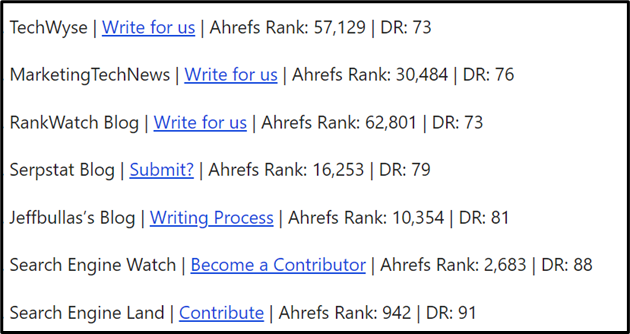
2. Influencer Marketing:
- Identify key influencers: Partner with industry experts, thought leaders, or niche bloggers who resonate with your target audience.
- Collaborate on valuable content: Co-create white papers, webinars, or podcasts addressing industry challenges and showcasing your expertise.
- Leverage their reach: Utilize their established audience to amplify your message and build brand awareness.
- Nurture authentic partnerships: Treat them as valued partners, not just marketing tools. Offer mutual benefits and respect their influence.
3. Create Shareable Content:
- Industry insights with a twist: Go beyond dry reports. Infographics, data visualizations, or interactive tools make complex information engaging.
- Problem-solving content: Address common pain points your target audience faces and offer practical solutions through blog posts, case studies, or guides.
- Leverage social media: Optimize content for different platforms and encourage sharing with relevant hashtags and calls to action.
- Run targeted contests: Partner with relevant bloggers to incentivize content creation and social sharing around your brand or industry topic.
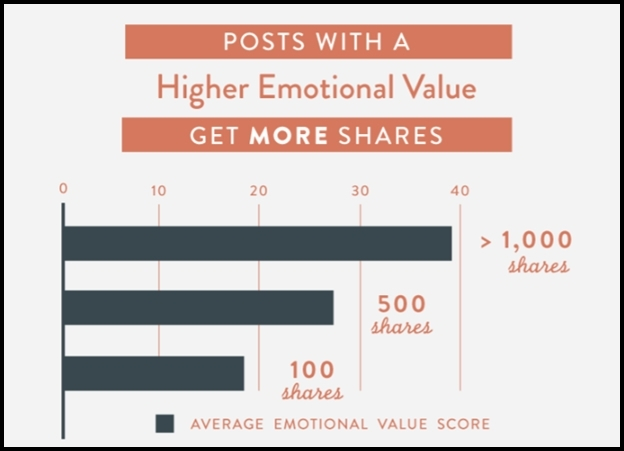
Source: buffer.com
—————————————————————————————————————————————————————–
How to Craft an SEO outreach strategy for B2B success:
Build relationships, leverage data, and create targeted content that resonates with decision-makers.
—————————————————————————————————————————————————————–
SEO Outreach in B2C Digital Marketing
Conversely, in the B2C realm, Search engine optimization outreach serves as a catalyst for engaging with individual consumers, driving brand awareness, and facilitating seamless interactions across diverse consumer segments. Key considerations and B2C SEO strategies for effective search engine optimization outreach in B2C digital marketing include Consumer-Centric Keyword Optimization, User-Centric Content Creation, E-commerce and Local Search engine optimization, Social Media Integration and Influencer Collaboration.

B2C Blogger Outreach Strategies: Engaging Communities and Sparking Conversation
B2C outreach thrives on emotional connection and captivating content. Here are key strategies to spark engagement and build brand love:
1. Interactive Experiences:
- Run contests and giveaways: Partner with relevant bloggers to host product giveaways, photo contests, or user-generated content challenges. This incentivizes interaction and brand awareness.
- Livestream events: Partner with micro-influencers for Q&A sessions, product demonstrations, or behind-the-scenes glimpses. Build a sense of community and excitement.
- Interactive quizzes and polls: Engage audiences with fun quizzes about your products or industry trends. Offer personalized discounts or recommendations based on results.

2. User-Generated Content (UGC):
- Encourage user-generated content: Partner with micro-influencers to create authentic product reviews, tutorials, or lifestyle content featuring your brand.
- Host hashtag campaigns: Encourage user-generated content with branded hashtags and incentives. Showcase the best submissions on your website and social media.
- Run UGC contests: Encourage photo or video submissions showcasing their experience with your brand. Reward creativity and offer exciting prizes.
3. Leverage Social Media Communities:
- Join relevant communities: Engage in discussions, answer questions, and offer valuable insights within relevant online communities and forums. Build trust and brand recognition.
- Partner with community leaders: Collaborate with community moderators or influential members to host AMAs, product demos, or exclusive events. Reach a targeted audience within a trusted space.
- Run community-specific promotions: Offer exclusive discounts or contests targeted towards specific online communities to incentivize engagement and brand loyalty.
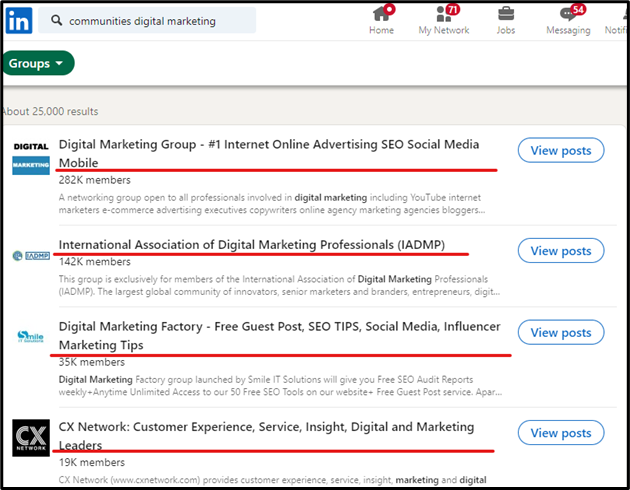
—————————————————————————————————————————————————————–
What is B2C SEO?
B2C SEO optimizes your online presence to attract individual consumers through search engines. Think engaging content, strategic keywords, and mobile-friendliness – all crafted to drive website visits and convert them into customers.
—————————————————————————————————————————————————————–
Common Principles and Best Practices
While the nuances of SEO outreach in B2B and B2C digital marketing are distinct, several common principles and best practices underpin the effectiveness of SEO outreach in both domains, including Content Quality and Relevance, User Experience and Mobile Optimization, Performance Monitoring and Data-Driven Optimization, Adaptation to Search Engine Algorithms and Trends.
Mastering the Double Play: B2B vs. B2C SEO Outreach in 2024
While both aim to build authority and attract leads, B2B and B2C SEO outreach strategies differ due to their unique target audiences and buying journeys. Here’s a quick breakdown:
| Feature | B2B | B2C |
| Target Audience | Decision-makers, businesses | Individual consumers |
| Sales Cycle | Longer, more complex | Shorter, impulse-driven |
| Focus | Building relationships, industry expertise | Brand awareness, emotional connection |
| Platforms | Industry publications, professional networks | Social media, influencer marketing |
| Content | White papers, case studies | Engaging visuals, interactive formats |
| Metrics | Domain authority, backlinks | Brand mentions, social engagement |
Current Trends in SEO Outreach:
Navigating the Ever-Evolving Landscape of SEO Outreach: Expert Insights from 10 Years in the Trenches
Gone are the days of generic, spray-and-pray outreach emails. Today’s SEO landscape demands a sophisticated, data-driven, and personalized approach that builds genuine relationships and resonates with your target audience. Here’s what I’ve learned in my 10-year journey, exploring the key trends shaping the future of SEO outreach:
1. Personalization is King (and Queen):
Forget mass blasting – it’s time to craft messages tailored to individual influencers and their audiences. Consider:
- Researching: Dive deep into their content, interests, and values to find common ground.
- Segmenting: Group influencers by niche, demographics, and engagement levels for targeted pitches.
- Hyper-personalizing: Use dynamic variables to address them by name and reference specific content they’ve created.
The ROI: A study by Yesware found that personalized emails have a 14% higher open rate and a 6% higher reply rate than generic ones.
Real-world example: Buzzsumo, a content marketing platform, saw a 300% increase in outreach success by personalizing pitches with relevant data about influencers’ past shares.
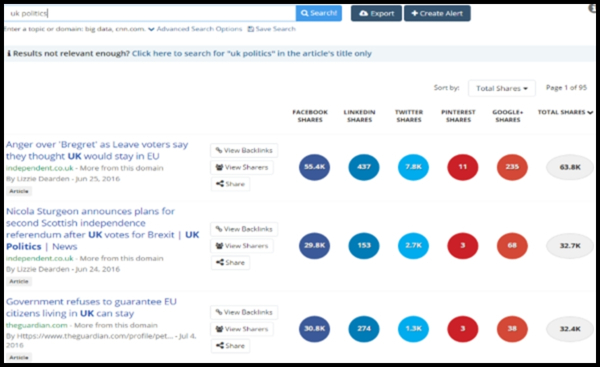
2. Data Drives Decisions:
Don’t gamble on gut feeling, leverage data to identify high-potential targets and track campaign performance. Tools like:
- Buzzsumo: Analyze trending topics and identify relevant influencers.
- Ahrefs: Track competitor backlinks and discover potential outreach partners.
- Google Analytics: Measure traffic sources and identify influencers driving valuable visits.
The stat: Marketing Charts reports that 87% of marketers leverage data analytics to identify marketing opportunities.
Real-world example: SEMrush, a SEO software company, used data to identify relevant podcasts, secured guest appearances, and saw a 40% increase in organic traffic.
3. New Platforms Emerge:
Expand your reach beyond traditional blogs and websites. Consider:
- Podcasts: Guest appearances on relevant podcasts can tap into engaged audiences and build brand authority.
- Social media communities: Engaging with niche groups on platforms like Reddit and Discord fosters meaningful connections and brand advocacy.
- Live video platforms: Platforms like Twitch and YouTube Live offer interactive opportunities to connect with audiences in real-time.
The potential: Social media influencer marketing is expected to reach a $16.4 billion industry by 2025.
Real-world example: Dollar Shave Club partnered with micro-influencers on Instagram, reaching a targeted audience and achieving a 25% increase in sales.
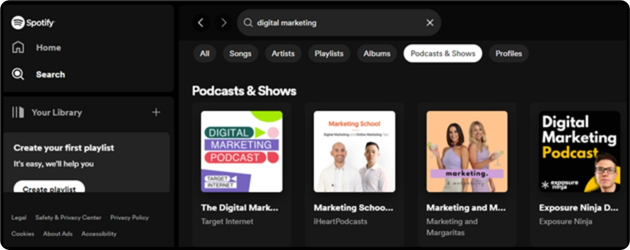
4. Micro-Influencers Make a Mark:
Forget celebrity endorsements, micro-influencers (10k-50k followers) offer higher engagement rates and authentic reach. They:
- Possess specific expertise and resonate with niche audiences.
- Foster trust and connection, making their recommendations more impactful.
- Offer better value for your outreach budget compared to big-name influencers.
The stat: Influencer marketing platform AspireIQ found that micro-influencers generate 6 times more engagement per follower than mega-influencers.
Real-world example: Eos Lip Balm partnered with micro-influencers in the beauty niche, resulting in a 400% increase in website traffic and a 20% rise in sales.
5. Voice Search Optimization:
With voice assistants like Siri and Alexa becoming increasingly popular, optimizing your outreach Search engine optimization strategy for voice search is crucial. Consider:
- Long-tail keywords: Focus on natural language phrases people use in voice searches.
- Structured data: Implement schema markup to improve voice search rankings.
- Content clarity: Create concise and informative content that answers specific questions.
The fact: Gartner predicts that 30% of all web searches will be conducted without a screen by 2020.
Real-world example: The Home Depot optimized its website for voice search, resulting in a 20% increase in voice-driven mobile conversions.
6. Content & Outreach Hand-in-Hand:
Your outreach efforts thrive when backed by high-quality content that resonates with your target audience. Integrate:
- Blog posts: Offer valuable insights and data relevant to influencers’ and their audiences’ interests.
- Infographics and visual content: Grab attention and simplify complex information for better engagement.
- Interactive tools and quizzes: Create experiences that encourage participation and generate data for future outreach.
The synergy: A study by Content Marketing Institute revealed that companies with blogs generate 55% more leads than those without.
Real-world example: Buffer, a social media management platform, created engaging infographics and secured backlinks from high-authority websites
—————————————————————————————————————————————————————–
Ennoble excelling at SEO Outreach for clients!
With 7+ years of digital marketing mastery, Ennoble Technologies crafts powerful B2B SEO strategies & B2C SEO outreach campaigns. Our team, led by a 10+year SEO veteran, delivers results that fuel your growth. Uncover the latest trends and proven SEO strategies to engage your audience and dominate the online space. Partner with Ennoble and turn website visitors into loyal customers today!
—————————————————————————————————————————————————————–
B2B Outreach: Mastering the Complex Game – Leveraging 10 Years of Expertise
B2B outreach is a different beast compared to its B2C counterpart. Longer sales cycles, complex decision-making processes, and the need for trust-building require a strategic and nuanced approach. Here, I’ll draw on my 10 years of experience to equip you with powerful B2B outreach best practices:
Understanding the Key Differences:
- Decision-Making: B2B purchases involve multiple stakeholders with diverse needs and concerns. Understand your target company’s buying journey and identify key decision-makers.
- Relationships Matter: Building genuine connections with individuals, not just titles, is crucial. Focus on providing value, not just pitching your product.
- Content is King: Offer insightful content like white papers, case studies, and industry reports that address specific pain points and showcase your expertise.
Actionable Tips for Success:
1. Research is King:
- Target the right companies: Use tools like ZoomInfo or LeadGenius to identify ideal prospects aligned with your solution.
- Know your decision-makers: Research their backgrounds, interests, and challenges to personalize your outreach.
- Understand their industry: Stay updated on industry trends and challenges to position your message for relevance.
2. Personalization is Key:
- Craft email introductions by name: Avoid generic templates and mention something specific about their work or interests.
- Offer tailored solutions: Highlight how your product/service addresses their unique needs and challenges.
- Go beyond email: Consider personalized LinkedIn messages, thought leadership pieces, or even handwritten notes for high-value targets.
3. Leverage Industry Events and Networks:
- Participate in relevant conferences and trade shows: Network with potential partners and decision-makers.
- Join industry associations and online communities: Build relationships and establish your expertise through thought leadership.
- Speak at industry events: Showcase your knowledge and gain credibility within the target audience.
4. Cultivate Relationships with Media and Influencers:
- Identify journalists and publications covering your industry: Build relationships by offering valuable insights and data.
- Contribute guest articles or industry reports: Gain exposure and establish your brand as a thought leader.
- Partner with relevant influencers: Leverage their reach and credibility to connect with key decision-makers.
5. Data & Analytics: Your Guiding Light:
- Track key metrics: Monitor open rates, click-through rates, and website traffic generated from your outreach efforts.
- Identify what’s working and what’s not: A/B test different subject lines, messaging strategies, and content formats.
- Refine your approach: Use data to continuously improve your outreach campaigns and maximize ROI.
Real-World Success Stories:
Case Study: A B2B SaaS company identified key decision-makers at target companies through LinkedIn research. By sending personalized emails with relevant case studies, they secured a 30% meeting acceptance rate.
Industry Example: A marketing agency built relationships with industry journalists by offering unique data and insights. They secured several media placements that generated qualified leads.
Remember, B2B outreach is a marathon, not a sprint. By implementing these best practices and leveraging my 10 years of experience, you can build genuine relationships, create value, and ultimately turn leads into loyal customers for your B2B business.
Cracking the B2C Code: Engaging Outreach B2C Strategies for Today’s Consumers
B2C outreach is a vibrant dance compared to its B2B counterpart. Shorter sales cycles, emotional triggers, and the need to grab attention demand a dynamic and engaging approach.
Leveraging my 10 years of experience, let’s delve into powerful B2C outreach best practices:
Understanding the Key Differences:
- Emotional Connection: Tap into emotions like excitement, joy, or fear to trigger impulsive desires and encourage action.
- Faster Conversions: B2C purchases often happen quickly, so ensure your outreach is clear, concise, and easily leads to conversion.
- Content is King, But Engagement is Queen: Go beyond informative content; create interactive experiences, user-generated content, and shareable moments.
Actionable Tips for Captivating Your Audience:
1. Master the Social Media Game:
- Engage with your audience: Respond to comments, participate in conversations, and run polls to foster a sense of community.
- Leverage influencer marketing: Partner with relevant micro-influencers who resonate with your target audience for authentic reach.
- Run contests and giveaways: Generate excitement and incentivize user interaction with appealing prizes.
2. Create Content that Sizzles:
- Focus on visuals: Utilize captivating images, videos, and infographics that grab attention and tell a story.
- Go interactive: Implement quizzes, polls, and augmented reality experiences to boost engagement.
- Optimize for mobile: Ensure your content displays flawlessly and is easily consumable on smartphones and tablets.
3. Personalization Matters, Even in the Crowd:
- Segment your audience: Create targeted campaigns based on demographics, interests, and past behavior.
- Use dynamic personalization tools: Address individuals by name and tailor messaging based on their preferences.
- Offer exclusive deals and promotions: Reward loyal customers and incentivize repeat purchases.
4. Data & Analytics: Your Performance Compass:
- Track key metrics: Monitor engagement rates, click-through rates, and conversion rates across different platforms and campaigns.
- Run A/B tests: Experiment with different headlines, images, and calls to action to see what resonates best.
- Refine your approach: Use data to continuously improve your outreach efforts and maximize ROI.
Real-World Success Stories:
Case Study: A clothing brand partnered with micro-influencers in the fashion niche. User-generated content featuring the brand led to a 20% increase in website traffic and a 15% rise in sales.
Industry Example: A food delivery app ran a social media campaign with a personalized quiz to recommend dishes. This interactive experience boosted engagement by 30% and generated valuable customer data.
Remember, B2C outreach is about creating a connection and a conversation. By implementing these best practices and leveraging my 10 years of experience, you can reach your target audience, captivate their attention, and ultimately convert them into loyal brand advocates.
Top SEO Outreach Tools:
Crafting a successful SEO outreach campaign requires the right tools to identify targets, personalize emails, and track results. Here’s a list of top options, both free and paid, categorized by their function:
| Category | Tool (Free) | Tool (Paid) |
| Target Identification | ||
| Buzzsumo | Semrush, SpyFu, Majestic, Similarweb Pro | |
| Ahrefs Backlink Checker | Buzzsumo Pro, Buzzstream | |
| Google Search Console | LinkMiner, BuzzStream Sumo | |
| Social Mention | Ahrefs Content Explorer, SE Ranking | |
| HARO | Pitchbox Guestlist, Traackr | |
| AnswerThePublic | Buzzsumo Influencers, Followerwonk | |
| Reddit Keyword Search | Pitchbox Alerts, Brand24 | |
| Quora Topic Search | Followerwonk Pro, Mention | |
| Email Personalization | ||
| Gmail Merge | Mailshake, Pitchbox, Voila Norbert | |
| Hunter | Respona, Pitchbox Email Finder | |
| MailChimp (up to 2,000 contacts) | Snov.io, ContactOut | |
| Streak for Gmail | Outreach.io, Saleshandy | |
| Boomerang for Gmail | Klout, Buzzsumo Influencers | |
| Content Creation & Tracking | ||
| Canva | Buzzsumo Sumo, Buffer, Similarweb Pro | |
| Google Analytics | Buzzsumo Pro, Pitchbox Insights | |
| Piktochart | Visme, Lumen5 | |
| Unsplash | Freepik, Storyblocks | |
| Animoto | InVideo, Wideo | |
| Google Trends | SEMrush Content Assistant, Ahrefs Content Ideas | |
| Relationship Building | ||
| LinkedIn, Twitter, HARO | Pitchbox Guestlist, Brand24, Buzzsumo Influencers | |
| Facebook Groups | Followerwonk Pro, Traackr | |
| Reddit Communities | Buzzstream, LinkMiner | |
| Quora Spaces | Ahrefs Alerts, SEMrush Brand Monitoring | |
| Discord Servers | Pitchbox Community, Buzzsumo Connect | |
| Online Events & Webinars | Traackr Discover, Buzzsumo Events | |
| Podcast Appearances | Podchaser, Matchmaker.fm |
Unlock the Power of Blogger Outreach: Turn Social Likes into Leads!
- Facebook:
Turn likes into leads! Unlock powerful B2B & B2C blogger outreach strategies & convert 70% of website visitors with free & paid tools. Get the insider tips in our blog! #SEO #leadgeneration #searchengineoptimization - Instagram:
Convert clicks to customers! Discover killer B2B & B2C blogger outreach hacks & skyrocket your lead generation with free & paid tools. Link in bio! #SEOtips #businessgrowth - LinkedIn:
Boost your sales funnel! Learn 70% conversion secrets via B2B & B2C blogger outreach & power up your lead generation with free & paid tools. Read our blog now! #B2Bmarketing #C2Cmarketing
—————————————————————————————————————————————————————–
Interesting fact – Did you know?
The average salary for an SEO outreach specialist in the United States is over $70,000 per year.
—————————————————————————————————————————————————————–
FAQs about SEO outreach specialists
Q. What skills do I need to be an SEO outreach specialist?
A. You will need strong communication and writing skills, as well as a good understanding of Search engine optimization and content marketing. You should also be able to use data analysis tools and be comfortable building relationships with people online.
Q. What is the career outlook for SEO outreach specialists?
A. The career outlook for Search engine optimization outreach specialists is very positive. The demand for SEO professionals is expected to grow in the coming years, as businesses increasingly recognize the importance of online marketing.
Q. How can I get started as an SEO outreach specialist?
A. There are a number of ways to get started as an SEO outreach specialist. You can take online courses or attend workshops to learn the skills you need. You can also start by building your own website or blog and practicing your outreach skills by trying to get backlinks from other websites.
Boost Your SEO with Influencer Outreach: The Complete Guide to Landing IoT Guest Posts
Targeting an IoT Influencer for a Guest Post Backlink: Step-by-Step Guide
Target: John Doe, Sr. Vice president of MagicCloud
Tools:
- Buzzsumo: Identify influencer’s best guest posts.
- Hunter: Find target’s email address.
- Mailshake: Personalize and send outreach emails.
Steps:
1. Research & Identify:
- Use Buzzsumo to find the influencer’s most popular guest posts on IoT topics.
- Analyze the posts for insights about their preferred content style and audience.
2. Craft a personalized pitch:
Use Hunter to find the influencer’s professional email address (avoid generic info@ emails). Draft a personalized email using Mailshake.
Here’s a sample script:
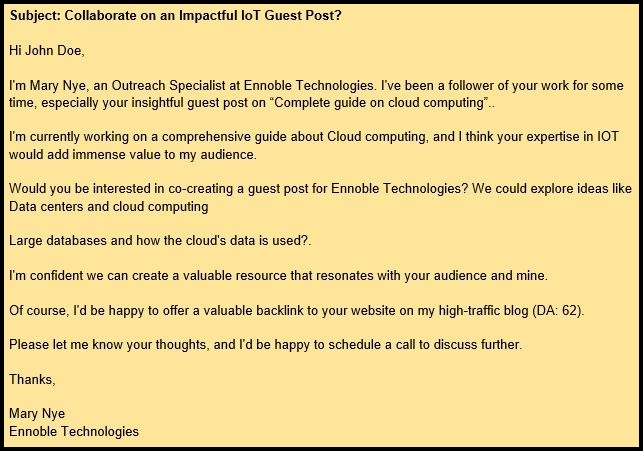
3. Personalize and Send:
- Use Mailshake’s personalization features to insert the influencer’s name, specific post title, and other relevant details.
- Send the email at an appropriate time, considering their location and time zone.
4. Follow Up:
- If you don’t receive a response within a week, send a courteous follow-up email using Mailshake.
- Be respectful of their time and avoid being pushy.
5. Negotiate & Secure Guest Post:
- If they express interest, discuss the topic, content outline, and desired backlink placement.
- Collaborate on creating a high-quality guest post that benefits both your audiences.
Remember:
- Focus on offering value and building a genuine connection.
- Respect the influencer’s time and expertise.
- Be patient and persistent, but not pushy.
- By following these steps and utilizing the recommended tools, you can increase your chances of securing a valuable backlink on an influential IoT blogger’s website.
Conclusion
In essence, the role of SEO outreach in both B2B and B2C digital marketing is rooted in enhancing online visibility, driving relevant traffic, and fostering meaningful connections with target audiences. By tailoring search engine optimization outreach strategies to the unique dynamics of B2B and B2C markets, organizations can position themselves for sustained success, drive engagement, and achieve business objectives within their respective domains. Whether engaging with businesses or individual consumers, the strategic deployment of search engine optimization outreach remains fundamental to achieving digital marketing success across diverse sectors.
Also Read: Mobile Optimization: Crucial for On-Page SEO Success – Ennoble Technologies
Also Read: On-Page SEO vs. Off-Page SEO: Which Matters More? – Ennoble Technologies
Also Read: Mastering On-Page SEO: Practical Tips & Tricks – Ennoble Technologies
Also Read: 10 On-Page SEO Mistakes You Must Avoid – Ennoble Technologies

